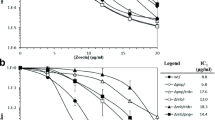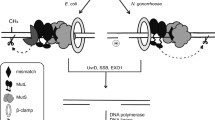Abstract.
Neisseria gonorrhoeae lacks several common DNA repair pathways found in other organisms. As recent evidence had indicated that gonococci use recombinational repair to repair UV-induced DNA lesions, this study examined whether the gonococcal RecJ homologue contributes in this repair capacity. The recJ gene from strain MS11 was cloned and sequenced and was found to show a considerable degree of identity to its Escherichia coli homologue. A N. gonorrhoeae Δ recJ mutant was constructed and tested for recombinational proficiency as well as for defects in DNA repair. In the absence of the RecJ exonuclease, DNA transformation and pilin switching occurred at wild type levels, indicating that the efficiency of recombination remained unimpaired. In contrast, N. gonorrhoeae ΔrecJ mutants showed extreme sensitivity to low levels of UV irradiation and to exposure to DNA-alkylating reagents [e.g. ethyl methanesulfonate (EMS) and methyl methanesulfonate (MMS)]. Complementation of the gonococcal recJ mutant in cis restored resistance to low-level UV, indicating that the gonococcal RecJ protein is involved in recombinational repair, and can act independently of other single-strand-specific exonucleases. Furthermore, transformation competence was not required for RecJ-dependent DNA repair. Overall, the data show that N. gonorrhoeae recJ mutants present a unique phenotype when compared to their E. coli recJ counterparts, and further support the contention that RecORJ-dependent recombinational repair is a major DNA repair pathway in the genus Neisseria.
Similar content being viewed by others
Author information
Authors and Affiliations
Additional information
Electronic Publication
Rights and permissions
About this article
Cite this article
Hill, S. Neisseria gonorrhoeae recJ mutants show defects in recombinational repair of alkylated bases and UV-induced pyrimidine dimers. Mol Gen Genet 264, 268–275 (2000). https://doi.org/10.1007/s004380000316
Received:
Accepted:
Published:
Issue Date:
DOI: https://doi.org/10.1007/s004380000316




